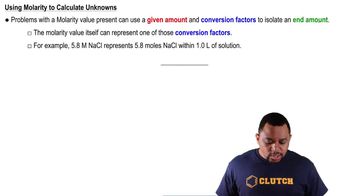Urea (CH4N2O) is a common fertilizer that is synthesized by the reaction of ammonia (NH3) with carbon dioxide: 2 NH3(aq) + CO2(aq) → CH4N2O(aq) + H2O(l) In an industrial synthesis of urea, a chemist combines 136.4 kg of ammonia with 211.4 kg of carbon dioxide and obtains 168.4 kg of urea. Determine the limiting reactant, theoretical yield of urea, and percent yield for the reaction.
Ch.4 - Chemical Quantities & Aqueous Reactions

Chapter 4, Problem 53a,b
Calculate the molarity of each solution.
a. 3.25 mol of LiCl in 2.78 L solution
b. 28.33 g C6H12O6 in 1.28 L of solution
 Verified step by step guidance
Verified step by step guidance1
Identify the formula for molarity: \( M = \frac{\text{moles of solute}}{\text{liters of solution}} \).
Determine the number of moles of solute, which is given as 3.25 mol of LiCl.
Determine the volume of the solution in liters, which is given as 2.78 L.
Substitute the values into the molarity formula: \( M = \frac{3.25 \text{ mol}}{2.78 \text{ L}} \).
Simplify the expression to find the molarity of the solution.

Verified video answer for a similar problem:
This video solution was recommended by our tutors as helpful for the problem above.
Video duration:
1mWas this helpful?
Key Concepts
Here are the essential concepts you must grasp in order to answer the question correctly.
Molarity
Molarity is a measure of concentration defined as the number of moles of solute per liter of solution. It is expressed in units of moles per liter (mol/L). Molarity is crucial for understanding how concentrated a solution is and is commonly used in chemistry to prepare solutions and perform stoichiometric calculations.
Recommended video:
Guided course

Molarity
Moles
A mole is a fundamental unit in chemistry that quantifies the amount of substance. One mole corresponds to approximately 6.022 x 10²³ entities, such as atoms or molecules. Understanding moles is essential for converting between mass and number of particles, which is necessary for calculating molarity.
Recommended video:
Guided course

Mole Concept
Volume of Solution
The volume of a solution is the total space that the solution occupies, typically measured in liters (L) or milliliters (mL). In molarity calculations, the volume of the solution is critical as it serves as the denominator in the molarity formula, directly affecting the concentration of the solute in the solution.
Recommended video:
Guided course

Constant-Volume Calorimetry
Related Practice
Textbook Question
8569
views
1
comments
Textbook Question
Many computer chips are manufactured from silicon, which occurs in nature as SiO2. When SiO2 is heated to melting, it reacts with solid carbon to form liquid silicon and carbon monoxide gas. In an industrial preparation of silicon, 155.8 kg of SiO2 reacts with 78.3 kg of carbon to produce 66.1 kg of silicon. Determine the percent yield for the reaction.
1703
views
Textbook Question
Calculate the molarity of each solution.
c. 32.4 mg NaCl in 122.4 mL of solution
2088
views
Textbook Question
Calculate the molarity of each solution. a. 0.38 mol of LiNO3 in 6.14 L of solution b. 72.8 g C2H6O in 2.34 L of solution c. 12.87 mg KI in 112.4 mL of solution
Textbook Question
What is the molarity of NO3– in each solution? a. 0.150 M KNO3 b. 0.150 M Ca(NO3)2 c. 0.150 M Al(NO3)3
2189
views
